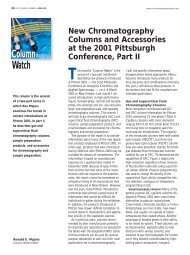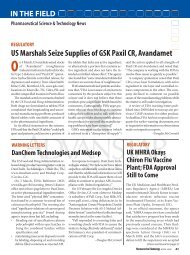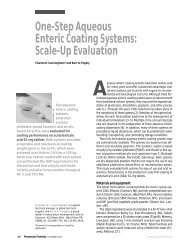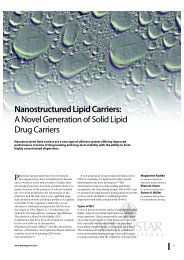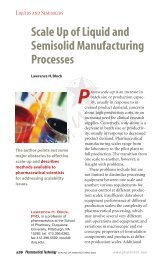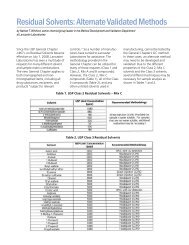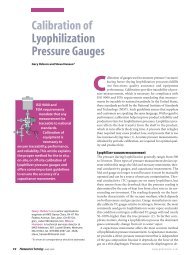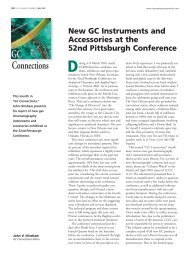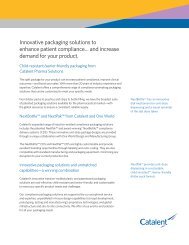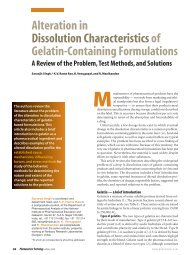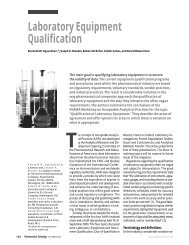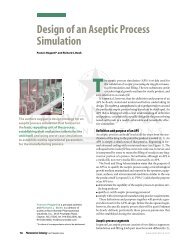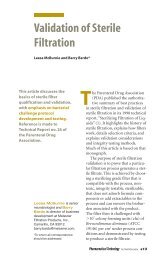Frequently Asked Questions - Pharmaceutical Technology
Frequently Asked Questions - Pharmaceutical Technology
Frequently Asked Questions - Pharmaceutical Technology
Create successful ePaper yourself
Turn your PDF publications into a flip-book with our unique Google optimized e-Paper software.
6 <strong>Frequently</strong> <strong>Asked</strong> <strong>Questions</strong><br />
16. Are Carbopol ® polymers effective tablet binders? What is the best way of incorporating them as binders in a<br />
matrix system?<br />
Carbopol ® polymers are efficient tablet binders. Formulations comprising Carbopol ® polymers generally do not require an additional<br />
binder to be used.<br />
In the case of wet granulation formulations, it is recommended to incorporate the polymer in the powder blend (0.5 - 3.0% w/w)<br />
versus adding it as an aqueous dispersion due to the high viscosity of the polymer. Carbopol ® polymer dispersions (maximum 1%)<br />
can be used for fluid bed granulation.<br />
17. What manufacturing processes can be used to produce solid dosage forms containing Carbopol ® polymers?<br />
Carbopol ® polymers can be processed by direct compression or by various granulation technologies (wet, dry, fluid bed, spray<br />
drying, extrusion spheronization and hot melt extrusion).<br />
18. Can Carbopol ® polymers be used in wet granulation processes? How?<br />
Carbopol ® polymers can be used in wet granulation processes. Key recommendations to facilitate processing are as follows:<br />
• In order to avoid fast and extensive swelling of the polymer, use a low amount of granulation liquid added at a slow rate in<br />
fine droplets (uniform distribution of the water in the wet mass). In general, a lower quantity of granulation liquid is used with<br />
Carbopol ® polymers compared to hypromellose.<br />
• Incorporation of microcrystalline cellulose improves the processability of the formulation. Generally less than 10% of<br />
microcrystalline cellulose should be used to prevent disintegration of the tablets.<br />
• Granulation should be controlled in order to prevent overwetting (sticky, rubbery mass).<br />
• It is very important to control the drying process and residual moisture in the granules (typical values 1 - 3%), however these<br />
parameters are formulation specific. If overdried, Carbopol ® polymers form hard granules. High residual moisture might lead to<br />
tablets sticking to the punches and stability problems.<br />
19. What is the recommended procedure for cleaning equipment after processing with Carbopol ® polymers?<br />
Water, solution of electrolytes (sodium chloride) or diluted caustic solutions can be used to clean equipment after processing<br />
with Carbopol ® polymers. Spraying those solutions under pressure generally increases cleaning efficiency. The electrolyte solution<br />
facilitates equipment cleaning by collapsing the gel.<br />
20. How do you quantify the API level in a Carbopol ® polymer matrix tablet?<br />
In order to ensure total recovery of the API from the Carbopol ® polymer tablets, it is recommended to run the analysis after<br />
grinding the tablets. Key considerations are as follows:<br />
• The API is extracted from the crushed tablets by sonication or other mixing techniques.<br />
• The criteria for solvent selection are API solubility and reduced polymer swelling. Examples of solvents in which the polymer<br />
does not swell extensively are anhydrous ethanol or an acidic aqueous solution at pH~1.2.<br />
• The extraction method has to be optimized; generally larger solvent volume and longer sonication time improve the API<br />
recovery, but have to be tested to determine if they affect the API stability.<br />
• Addition of an electrolyte (sodium chloride) to the extraction solvent may improve the recovery (ion effect on the polymer).



